The Case Lifts Apart From the Base for Moving Purposes Art
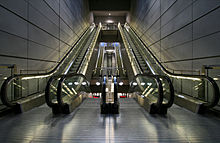
Fujitec Escalator in action, 2020
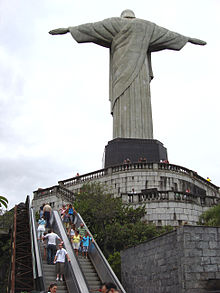
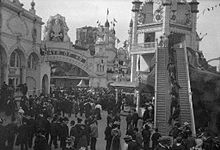
Early escalator, Luna Park, Coney Island, 1909.
An escalator is a moving staircase which carries people betwixt floors of a building or construction. Information technology consists of a motor-driven chain of individually linked steps on a runway which wheel on a pair of tracks which go on them horizontal.
Escalators are often used around the world in places where lifts would be impractical, or they can be used in conjunction with them. Principal areas of usage include department stores, shopping malls, airports, transit systems (railway/railroad stations), convention centers, hotels, arenas, stadiums and public buildings.
Escalators accept the capacity to movement large numbers of people. They have no waiting interval (except during very heavy traffic). They can be used to guide people toward main exits or special exhibits and may be weatherproofed for outdoor use. A not-functional escalator tin can function as a normal staircase, whereas many other methods of transport become useless when they pause downwards or lose power.
Design, components, and operation [edit]
Functioning and layout [edit]

Escalator at the Umeda Sky Building, Osaka, Nihon 2016

An animation of a moving escalator

Escalators typically rise at an angle of almost 30 degrees from the ground.[1] They motility at 0.3–0.half dozen metres per second (ane–2 ft/s) – like moving walkways – and may traverse vertical distances in backlog of 18 metres (60 ft). Most modernistic escalators have unmarried-piece aluminum or stainless steel steps that move on a organisation of tracks in a continuous loop.

"Crisscross" layout, Shanghai Museum
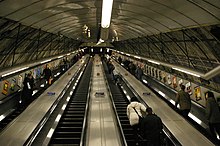
"Multiple parallel" layout, Holborn Station, London

"Parallel" layout, Target Store
Different types of escalators include:
- parallel (up and down escalators adjacent or nearby, oftentimes seen in perpendicular areas, metro stations and multilevel motion picture theaters);
- multiple parallel (banks of more than i escalator going in the same direction parallel to banks going the other direction);
- crisscross (escalators going in one direction "stacked" with escalators going the opposite management oriented adjacent just perpendicular, often used in section stores or shopping centers).[2]
Most countries crave escalators to have moving handrails that go along pace with the movement of the steps as a safety measure. This helps riders steady themselves, especially when stepping onto the moving stairs. Occasionally a handrail moves at a slightly different speed from the steps, causing it to "creep" slowly forward or astern relative to the steps; it is only slippage and normal wearable that causes such losses of synchronicity, and is not by design.[3]
The management of escalator movement (up or downward) can be permanently prepare, controlled manually depending on the predominant catamenia of the oversupply, or controlled automatically. In some setups, the direction is controlled by whoever arrives showtime.[ commendation needed ]
Blueprint and layout considerations [edit]
Pattern factors include physical requirements, location, traffic patterns, safety considerations and aesthetics. Concrete factors such equally the altitude to exist spanned decide the length and pitch of the escalator, while factors such equally the infrastructure's ability to provide support and power must be considered. How upward and downward traffic is separated and load/unload areas are other important considerations.
Temporal traffic patterns must be predictable. Some escalators need but to move people from one floor to another, but others may take specific requirements, such as funneling visitors towards exits or exhibits. The visibility and accessibility of the escalator to traffic is relevant. Designers need to account for the projected traffic volumes. For example, a unmarried-width escalator traveling at about 0.five metres per second (1+ one⁄two ft/southward) can move about 2000 people per hour, assuming that passengers ride single file. The carrying capacity of an escalator arrangement is typically matched to the expected acme traffic demand. For example, escalators at transit stations must be designed to cater for the peak traffic menstruum discharged from a train, without excessive bunching at the escalator archway.
In this regard, escalators help manage the menstruum of people. For instance, at many airports an unpaired escalator delivers passengers to an exit, with no ways for anyone entering at the exit to access the concourse.
Escalators are often built next to or around staircases that allow alternative travel betwixt the same ii floors. Elevators are necessary for inability access to floors serviced past escalators.
Components [edit]
Landing platforms [edit]
Landing platforms are the ii platforms (at the two ends) that business firm the curved sections of the tracks, every bit well as the gears and motors that drive the stairs. The elevation platform unremarkably contains the motor associates and the main drive gear, while the bottom holds the return gear. These sections also ballast the ends of the escalator truss. Each platform also has a floor and a comb plate. The floor plate provides a place for the passengers to stand before they stride onto the moving stairs, flush with the residue of the floor and normally hinged to let easy maintenance access, while the comb plate lies betwixt the stationary floor plate and the moving step, so named for the cleats on its edge which mesh with the matching cleats on each step (and resemble a comb). The interlocking cleats help to minimize the gap between the stairs and landing, preventing objects or persons from becoming caught in it.
Truss [edit]
The truss is the hollow metal construction that bridges the lower and upper landings, composed of two side sections joined together with cross braces across the bottom and just below the top. The ends of the truss are attached to the height and bottom landing platforms via steel or physical supports. It carries all the straight track sections connecting the upper and lower sections.
Balcony [edit]
The balustrade is composed of handrails, balustrade panels, and skirt panels:[four]
Handrail [edit]
The handrail provides a handhold for passengers while they are riding the escalator. The handrail is pulled along its own rail by a concatenation that is connected to the main bulldoze gear by a series of pulleys, keeping it at the same speed as the steps. Four distinct sections make up the rails: at its middle is a "slider", as well known equally a "glider ply", which is a layer of a cotton wool or constructed textile that allows the rail to motion smoothly forth its track. The "tension fellow member" lies on the slider and consists of either steel cable or apartment steel tape, providing the handrail with tensile strength and flexibility. The inner components, on top of the tension member, are made of chemically treated safety designed to preclude the layers from separating. Finally, the outer layer—the function that passengers run into—is the encompass, typically a alloy of synthetic polymers and rubber. Covers are designed to resist degradation from environmental conditions, mechanical clothing and tear and vandalism.
In a manufacturing plant, handrails are constructed past feeding rubber through an extrusion automobile to produce layers of the required size and type in order to match specific orders. The component layers of fabric, prophylactic and steel are shaped by workers before being fed into the presses which fuse them together.
In the mid-twentieth century, some handrail designs consisted of a prophylactic bellows, with rings of shine metallic cladding called "bracelets" between each coil. This gave the handrail a rigid yet flexible feel. Additionally, each bellows section was no more than around a metre long, so if part of the handrail was damaged, but the bad segment needed to be replaced. These forms of handrail have largely been replaced with textile-and-rubber railings.
Balustrade panel [edit]
Being made of either metal, sandwich panel, or drinking glass, the balustrade panel supports the handrails of the escalator. Information technology also provides additional protection for the handrail and passengers. Some escalators have direction arrows on the ends of the balustrade. Escalators' on/off buttons are frequently located at the ends of the balustrade. Moving walkways oft use balustrades in the same mode.
Brim Panel [edit]
The bottom of the balustrade is chosen a skirt console. It is notorious in this art for beingness a frequent site of injuries and failures, due to the possible entrapment of materials (including torso parts) in the machinery. Multiple solutions accept been suggested for this issue, including coating with a low-friction material, employing bristles, and others.[iv]
Tracks [edit]
The track system is built into the truss to guide the step concatenation, which continuously pulls the steps from the bottom platform and back to the tiptop in an endless loop. One runway guides the front wheels of the steps (called the stride-bike track) and another guides the back wheels of the steps (chosen the trailer-bike track). The relative positions of these tracks crusade the steps to form a staircase as they move out from under the comb plate. Forth the direct section of the truss the tracks are at their maximum altitude autonomously. This configuration forces the back of 1 footstep to be at a 90-caste bending relative to the step behind it. This right angle forces the steps into a shape resembling a staircase. At the top and bottom of the escalator, the two tracks converge so that the front and back wheels of the steps are about in a straight line. This causes the stairs to lay in a flat sheetlike organization, i after another, so they can easily travel around the bend in the curved section of track. The tracks carry the steps down along the underside of the truss until they accomplish the lesser landing, where they pass through another curved section of track before exiting the bottom landing. At this point, the tracks split up and the steps again assume a staircase configuration. This wheel is repeated continually as the steps are pulled from bottom to top and back to the lesser again.
Steps [edit]
The steps themselves are solid, i slice, die-cast aluminium or steel. Yellow demarcation lines are sometimes added to indicate their edges. In most escalator models manufactured later 1950, both the riser and the tread of each step is cleated (given a ribbed appearance) with comb-like protrusions that mesh with the comb plates on the peak and lesser platforms and the succeeding steps in the chain. Seeberger escalators featured flat treads and smoothen risers; other escalator models take cleated treads and shine risers. The steps are linked past a continuous metal concatenation that forms a closed loop. The front and back edges of the steps each have two wheels, the rear of which are set further apart and fit into the trailer-bike track while the front end set have narrower axles and fit the step-bicycle rails.
-
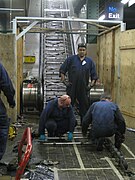
An escalator being repaired at Boondocks Hall station in Sydney, Australia
-
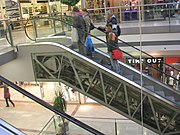
A "freestanding" escalator reveals its inner components through the transparent truss.
-
Escalator truss connects to the landing platform (lower left). Besides visible: exposed drive gears (centre) for steps and handrail drive (left)
-

View of an escalator'southward motor
-
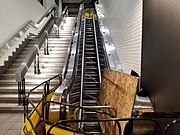
An escalator with its steps removed
-

View of escalator steps on continuous chain
-

An escalator equipped with a "bellows" handrail. The bracelets are colored grey, with occasional strings of black ones to announced equally moving spacers.etc
Rubber [edit]

Emergency Stop Button of escalator.


Escalators take a grip at their side for passengers aboard to hold.
Safety is a major business organisation in escalator design, as escalators are powerful machines that can become entangled with clothing and other items. Such entanglements can hurt or kill riders. In Republic of india many women wear saris, increasing the likelihood of entangling the clothing's loose end.[v] To prevent this, sari guards are congenital into most escalators in Republic of india.
Children wearing footwear such as Crocs and flip-flops are especially at risk of being caught in escalator mechanisms.[half dozen] [7] The softness of the shoe's material combined with the smaller size of children'due south feet makes this sort of accident especially common.[8]
Escalators sometimes include burn protection systems including automatic burn down detection and suppression systems within the dust collection and engineer pit. To limit the danger acquired past overheating, spaces that contain motors and gears typically include boosted ventilation. Small, targeted clean agent automatic extinguishing systems are sometimes installed in these areas. Fire protection of an escalator flooring opening is besides sometimes provided by adding automated sprinklers or fireproof shutters to the opening, or past installing the escalator in an enclosed fire-protected infinite.
Accidents [edit]

Crisscross layout of escalators at Mahboonkrong Center, widely known equally the MBK Eye, in Bangkok. Such layouts are used to minimize structural space requirements by "stacking" escalators that become in one direction.
King's Cross fire [edit]

The concluding wooden escalators in the London Underground were removed from Greenford station (pictured in 2006) in 2013.[nine]
The King's Cross fire of 1987 illustrated the demanding nature of escalator budget and the devices' propensity to collect "fluff" and other small debris when not properly maintained.[ten] The official inquiry determined that the burn down started slowly, smoldering almost undetected for a time, then exploded into the ticket hall above in a previously-unrecognised phenomenon now known as the "trench effect". In the escalators' undercarriage, approximately 8,800 kilograms (19,400 lb) of accumulated detritus acted as a wick to a neglected buildup of interior lubricants; woods veneers, newspaper and plastic advertisements, solvent-based pigment, plywood in the ticket hall, and melamine combustion added to the impact of the calamity.[eleven]
Following the study, older wooden escalators were removed from service in the London Underground. Additionally, sections of the London Surreptitious that were actually beneath ground were made non-smoking; ultimately, the whole system became a smoke-free zone.
Chongqing accident [edit]
In October 2015 on a Thursday morning, a 4-year-old boy suffocated and died in a Chinese train station in the city of Chongqing, China. The boy was playing with an escalator handrail when he fell and got stuck underneath it with his chest wedged betwixt the bottom of the handrail and the ground.[12]
Litigation [edit]
| | This section needs expansion with: examples and additional citations. You tin can help past calculation to it. (May 2022) |
In the 1930s, at least one accommodate was filed against a department store, alleging that its escalators posed an bonny nuisance, responsible for a kid's injury.[xiii]
Legislation [edit]
United States [edit]
Despite their considerable telescopic, the two Congressional Acts regarding accessibility (the Rehabilitation Deed of 1973 and the Americans with Disabilities Act of 1990 (ADA)) did not directly bear upon escalators or their public installations. Since Section 504 of the Rehabilitation Human action included public transportation systems, for a few years, the Usa Department of Transportation considered designs to retrofit existing escalators for wheelchair access. Nonetheless, Foster-Miller Assembly' 1980 plan, Escalator Modification for the Handicapped was ultimately ignored in favor of increased elevator installations in subway systems. Likewise, the ADA provided more than accessibility options, but expressly excluded escalators every bit "accessible means of egress", advocating neither their removal nor their retention in public structures.[14]
Codes and regulation [edit]

Find on escalators in Spain
In the United States and Canada, new escalators must bide by ASME A17.1 standards,[15] and old/celebrated escalators must conform to the prophylactic guidelines of ASME A17.3.[16] In Europe, the escalator safety code is EN 115.
History [edit]
Inventors and manufacturers [edit]
Nathan Ames [edit]

Illustration from U.South. Patent#25,076: Revolving Stairs. Issued Baronial 9, 1859, to Nathan Ames
Nathan Ames, a patent attorney from Saugus, Massachusetts, is credited with patenting the get-go "escalator" in 1859, despite the fact that no working model of his design was ever built. His invention, the "revolving stairs", is largely speculative and the patent specifications signal that he had no preference for materials or potential use (he noted that steps could be upholstered or fabricated of forest, and suggested that the units might do good the infirm inside a household apply). The suggested motive power was either manual or hydraulic.[17]
Leamon Souder [edit]
In 1889, Leamon Souder successfully patented the "stairway", an analogous device that featured a "serial of steps and links jointed to each other". No model was ever congenital.[18] This was the first of at to the lowest degree four escalator-style patents issued to Souder, including two for spiral designs.[19]
Jesse Wilford Reno, George A. Wheeler, and Charles Seeberger [edit]
On March 15, 1892, Jesse Due west. Reno patented the "Endless Conveyor or Elevator."[20] A few months after Reno'southward patent was approved, George A. Wheeler patented his ideas for a more recognizable moving staircase, though it was never built.[21] Wheeler'due south patents were bought past Charles Seeberger; some features of Wheeler'south designs were incorporated in Seeberger'southward prototype that was built by the Otis Elevator Company in 1899.
Reno, a graduate of Lehigh University, produced the kickoff working escalator (called the "inclined elevator") and installed it alongside the Former Iron Pier at Coney Island, New York City in 1896.[22] This item device was little more than an inclined belt with cast-iron slats or cleats on the surface for traction, and traveled along a 25 degree incline. A few months afterwards, the same prototype was used for a month-long trial menstruation on the Manhattan side of the Brooklyn Bridge. Reno eventually joined forces with Otis and retired once he had sold his patents. Some Reno-type escalators were however being used in the Boston subway until construction for the Big Dig (ca. 1991) precipitated their removal. The Smithsonian Institution considered re-assembling one of these historic units from 1914 in their drove of Americana, but "logistics and reassembly costs won out over nostalgia", and the project was discarded.[23]
Around May 1895, Charles Seeberger began drawings on a form of escalator similar to those patented by Wheeler in 1892. This device consisted of flat, moving stairs, not different the escalators of today, except for one important detail: the step surface was polish, with no comb issue to safely guide the passenger'south feet off at the ends. Instead, the rider had to stride off sideways. To facilitate this, at the top or bottom of the escalator the steps continued moving horizontally across the finish of the handrail (like a miniature moving sidewalk) until they disappeared under a triangular "divider" which guided the passenger to either side. Seeberger teamed with Otis in 1899, and together they produced the first commercial escalator. Information technology won kickoff prize at the 1900 Paris Exposition Universelle. Too on display at the Exposition were Reno's inclined lift, a like model past James M. Dodge and the Link Belt Machinery Co., and ii different devices by the French manufacturers Hallé and Piat.
Early European manufacturers: Hallé, Hocquardt and Piat [edit]
Piat installed its "stepless" escalator in Harrods Knightsbridge shop on Wednesday, November sixteen, 1898, though the company relinquished its patent rights to the section store. Noted past Bill Lancaster in The Department Store: a Social History, "customers unnerved by the feel were revived past shopmen dispensing free smelling salts and cognac."[24] The Harrods unit was a continuous leather belt fabricated of "224 pieces . . . strongly linked together traveling in an upward direction", and was the first "moving staircase" in England.[25]
Hocquardt received European patent rights for the Fahrtreppe in 1906. After the Exposition, Hallé continued to sell its escalator device in Europe simply was eventually eclipsed in sales by other major manufacturers.
American manufacturers and nomenclature [edit]
In the first half of the twentieth century, several manufacturers adult their own escalator products, though they had to market place their devices under unlike names, due to Otis' hold on the trademark rights to the word "escalator." New York-based Peelle Company chosen their models the Motorstair, while Westinghouse called their model an Electrical Stairway. The Toledo-based Haughton Elevator visitor referred to their product as merely Moving Stairs. The Otis trademark is no longer in event.
Mergers and buyouts: the playing field narrows [edit]
Kone and Schindler introduced their start escalator models several decades afterward the Otis Elevator Co., but grew to dominate the field over fourth dimension. Today, they, Mitsubishi, and ThyssenKrupp are Otis' primary rivals.
Kone expanded internationally by acquisition in the 1970s, buying out Swedish elevator manufacturer Asea-Graham, and purchasing other modest French, German and Austrian elevator makers earlier bold control of Westinghouse's European elevator business concern. Equally the last of the "big four" manufacturers to emerge onto the global market, Kone offset acquired Montgomery Elevator visitor, and so took control of Germany's Orenstein & Koppel Rolltreppen.[ citation needed ]
In the xx-kickoff century Schindler became the largest maker of escalators and second largest maker of elevators in the globe, though their first escalator installation did non occur until 1936.[26] In 1979, the visitor entered the Us market by purchasing Haughton Elevator. A decade later on, Schindler assumed command of the Northward American escalator/elevator operations of Westinghouse, forming Schindler's American division.
Alternating designs [edit]
Spiral/helical [edit]

Jesse Reno likewise designed the kickoff escalators installed in any underground subway organization in the form of a helical escalator at Holloway Road tube station in London in 1906. The experimental device never saw public apply and its remains are at present in the London Transport Museum's depot in Acton.[27] [28]
Although the first fully operational screw escalator, Reno's blueprint was nonetheless only one in a series of similar proposed contraptions. Souder patented 2 helical designs, while Wheeler drafted helical stairway plans in 1905. Seeberger devised at to the lowest degree 2 helical designs between 1906 and 1911 (including an unrealized arrangement for the London Underground), and Gilbert Luna obtained Westward German language, Japanese, and U.s. patents for his version of a spiral escalator by 1973. When interviewed for the Los Angeles Times that year, Luna was in the process of soliciting major firms for the conquering of his patents and visitor, but statistics are unclear on the outcome of these endeavors.[29] Karl-Heinz Pahl received a European and a US patent for a screw escalator in 1992.[30]
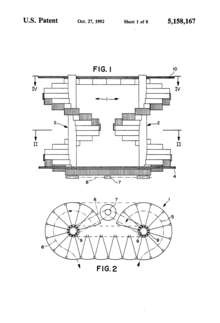
Spiral Escalator US Patent 5,158,167 (Pahl 1992) Drawing
The Mitsubishi Electric Corporation was most successful in its development of spiral/helical escalators, and it lone has sold them since the mid-1980s. The world'southward first practical spiral escalator—a Mitsubishi model—was installed in Osaka, Japan, in 1985.[31]
Helixator, an experimental spiral/helical escalator design that currently exists as a epitome scale model, could further reduce floor infinite demands. Its blueprint has several innovations that allow a continuous helix; driven by a linear motor instead of a chain system, it spreads force evenly along the escalator path, avoiding excessive strength on the top chain links and hence fugitive the geometry, length, and pinnacle limits of standard escalators.[32]
Westfield San Francisco Centre, San Francisco, California, United States — is the starting time spiral escalator in the Western Hemisphere.[33]
Freeform [edit]
Levytator, a design originating at City University in London, can move in straight lines or curves with or without rise or descending. The returning steps exercise not motion underneath the in-use steps: rather, they provide steps for travel in the contrary direction, every bit in the Pahl spiral escalator patent.[34]
Etymology [edit]
Authors and historians have offered multiple interpretations of the source of the word "escalator", and some caste of misinformation then proliferated. For reference, contradictory citations by 7 separate individuals, including the Otis Elevator Visitor itself, are provided below.[35]
Name development and original intentions [edit]
Seeberger trademarked the give-and-take "escalator" in 1900, to coincide with his device's debut at the Exposition universelle. Co-ordinate to his ain account, in 1895, his legal counsel advised him to name his new invention, and he then prepare out to devise a title for information technology. Every bit evidenced in Seeberger's handwritten documents, the inventor consulted "a Latin lexicon" and "adopted as the root of the new word, 'Scala'; every bit a prefix, 'E' and as a suffix, 'Tor.'"[36] His own rough translation of the word thus created was "ways of traversing from", and he intended for the discussion to be pronounced, "es‧ʹkæl‧ə‧tər" (es-CAL-a-tor). By 1906, Seeberger noted that the public had instead come to pronounce information technology "escə‧lāʹ‧tər" (es-ca-LĀ-tor).[37]
"Escalator" was not a combination of other French or Greek words, and was never a derivative of "elevator" in the original sense, which means "one who raises upward, a deliverer" in Latin.[38] Similarly, the root word "scala" does not hateful "a flight of steps", merely is the singular course of the plural noun "scalae", which tin denote whatever of: "a flight of steps or stairs, a staircase; a ladder, [or] a scaling-ladder."[38]
The declared intended capitalization of "escalator" is likewise a topic of fence. Seeberger's trademark application lists the discussion not simply with the "E", but likewise with all of the letters capitalized (in two different instances), and he specifies that "any other grade and grapheme of type may exist employed . . . without altering in any essential manner the character of [the] merchandise-marker."[39] Otis Elevator Co. advertisements so ofttimes capitalized all of the letters in the give-and-take.
Loss of trademark rights [edit]
In 1950, the landmark instance Haughton Elevator Co. v. Seeberger precipitated the end of Otis's exclusive reign over the word "escalator", and simultaneously created a cautionary report for companies and individuals interested in trademark retentivity.[xl] Confirming the contention of the Examiner of Trademark Interferences, Assistant Commissioner of Patents Irish potato's determination rejected Otis' entreatment to keep their trademark intact, and noted that "the term 'escalator' is recognized by the general public as the proper name for a moving stairway and not the source thereof", observing that Otis had "used the term equally a generic descriptive term . . . in a number of patents which [had] been issued to them and . . . in their ad matter."[41] All trademark protections were removed from the discussion "escalator", the term was officially genericized, and it roughshod into the public domain.
Extant celebrated escalator models [edit]

Macy's Herald Square store in New York Metropolis holds some well-known historic escalators. The model shown here, retrofitted with metal steps in the 1990s, is among the oldest of the shop's 40 escalators. Otis "L-blazon" escalators with distinctive wood treads (not shown) take operated in the store since 1927.

Notable examples of historic escalators still in operation include:
- Europe
- St Anna Pedestrian Tunnel underneath the Scheldt river in Antwerp, Kingdom of belgium, opened 1933.
- Maastunnel'due south bicycle/pedestrian tunnel, adjacent to its car tunnel in Rotterdam, The Netherlands, opened 1942.
- Tyne Cyclist and Pedestrian Tunnel, Tyne and Wear, England, constructed 1951.[42] [43]
- Due north America
- Macy's Herald Square department store upwards escalators, New York, U.S., opened 1920s.[44] [45]
Notable examples [edit]
Longest systems [edit]
- Key–Mid-Levels escalator, 790 yard (2,600 ft): in Hong Kong, tens of thousands of commuters travel each work day between Key and the Mid-Levels, a residential district over a hundred metres uphill, using this long-altitude organization of escalators and moving walkways. It is the world's longest outdoor escalator arrangement (non a single escalator span). Information technology goes but one way at a fourth dimension; the direction reverses depending on rush hour traffic management.
- A system of escalators connect Potenza, Italy, with its downhill neighbourhoods, the largest public escalator network in Europe.[46] The longest escalator is approximately 500 m (1,600 ft) in length.
- In December 2011, a network of vi escalators of 380 k (ane,260 ft) length, equivalent to 28 stories loftier, was opened in Medellín, Republic of colombia, offer the 12,000 residents of Comuna 13 a half-dozen-infinitesimal ride to the urban center eye compared to the previous 35-infinitesimal climb on human foot.
- Pour, Yerevan: an escalator system of 236 m (774 ft) length and 118 m (387 ft) height.
- Ocean Park, Hong Kong: a long escalator system connecting ii parts of the Park, with an overall length of 220 m (730 ft).
Longest individual escalators [edit]

World [edit]
- The longest escalators in the globe are installed in deep hole-and-corner stations of the Leningrad Metro. The Ploshchad Lenina, Chernyshevskaya, and Admiralteyskaya stations take escalators up to 138 m (453 ft) long and 69 one thousand (226 ft) loftier.
- The longest freestanding (supported only at the ends) escalator in the world is inside CNN Center'southward atrium in Atlanta. It rises 8 stories and is 62 g (205 ft) long. Originally built as the entrance to the amusement park The Earth of Sid and Marty Krofft, the escalator is now used for CNN studio tours.[47] [48]
Asia [edit]
- The Rustaveli station in the Tbilisi Metro has one of the world's longest escalators. Information technology is 60 metres (197 ft) high and 120 metres (394 ft) long.
- One of the longest unmarried escalators in Asia is Lianglukou Huangguan Escalator in Chongqing, China. It joins the Chongqing Rail Transit underground station Lianglukou with the overground railway station at Caiyuanba. The escalator is 112 m (367 ft) long and has a transit time of well-nigh 2 minutes 30 seconds. The ride costs 2 yuan. Due to the hilly nature of Chongqing, the surreptitious railway station is at the elevation of the escalator while the overground station is at the lesser.
- The longest escalator in Bangkok, Thailand and Southeast Asia is in the MRT's Si Lom Station. It connects the concourse level with platform 1 which in turn connects to Hua Lam Phong. It is 43 m (141 ft) in length and 21.5 m (71 ft) in depth.
Australia [edit]
- The longest set of single-span uninterrupted escalators in the Southern Hemisphere is at Parliament surreptitious railway station in Melbourne. A set of four escalators run from the southern concourse downwardly to platforms 1 and 2, with some other fix of three running from the northern concourse. Each are 30 metres (98 ft) long, taking well-nigh i infinitesimal and 25 seconds from top to lesser.[49]
- When the Forrestfield-Airdrome Link is complete, the longest unmarried-span uninterrupted escalator in the Southern Hemisphere will exist a triple-broad escalator inside Airdrome Central railway station from the elevated Skybridge to concourse level. The escalator is 15 yard high and 35 1000 long and was installed in June 2019 but is not notwithstanding operational.[fifty]
Europe [edit]

- Three stations in Saint petersburg Metro have escalators up to 138 k (453 ft) long and 69 m (226 ft) high: Ploshchad Lenina, Chernyshevskaya, and Admiralteyskaya.
- In the Park Pobedy station of the Moscow Metro, the escalators are 126.viii thousand (416 ft) or 740 steps long, and 63.4 m (208 ft) loftier. It takes three minutes to transit.
- The longest escalator in Prague, and in the European Union, is at the Náměstí Míru station at 87 m (285 ft) long and 43.4 1000 (142+ one⁄two ft) loftier.[51]
- The longest escalators in Western Europe are in the Elbphilharmonie in Hamburg with a length of 82 thousand (269 ft), in Helsinki Koivusaari Metro Station (76 m; 249 ft), in Helsinki Airport Railway Station (74 g; 243 ft),[52] and at Stockholm Metro station Västra skogen (67 m; 220 ft).[53] The new Stockholm Metro station in Nacka currently under structure volition have en escalator with a length of 82 m (269 ft).[54] [55]
- The tallest escalator on the London Secret system is at Angel station on the Northern line with a length of threescore grand (200 ft), and a vertical rising of 27 m (90 ft).[56]
- The longest wooden escalators in the United Kingdom are at the Tyne Cyclist and Pedestrian Tunnel, with a length of 60 thou (197 ft). (See to a higher place)
- The longest escalator of a European shopping mall is at MyZeil, Frankfurt, Germany, with a length of 45 m (150 ft).
- The largest "unmarried truss escalator" is in the Bentall Center in Kingston upon Thames in Greater London, UK. It connects the ground floor with the second flooring with top and bottom supports.[ citation needed ]
North and South America [edit]
- The longest set up of unmarried-bridge uninterrupted escalators in the Western Hemisphere is at Wheaton station on the Washington Metro Red Line. They are 70 m (230 ft)[57] [58] long with a vertical rise of 35 m (115 ft),[58] and take nearly 3-and-a-half minutes[59] to arise or descend without walking.
- The longest single-span escalator in a Canadian Transit system is at Rideau station of the Confederation Line in Ottawa. The escalator volition be 35.3 metres (116 ft) in length with a rise of 15.8 metres (52 ft) and 181 steps.[60]
Shortest examples [edit]
According to Guinness, the shortest escalator in the world is the "Puchicalator" in the Okadaya Mores shopping mall in Kawasaki Japan. Its vertical rise is 832 mm (32+ 3⁄4 in) and it has v steps.

Other brusque escalators include:
- Westfield Garden State Plaza, Paramus, New Jersey, United States — one of the shortest escalators in North America. This escalator led to the entrance of the JCPenney shop.[61] After the JCPenney closed in March 2018, the store and the escalator were walled up.
Etiquette [edit]

Riders stand to the right on this escalator in Umeda, Osaka, Japan
In most major countries, the expectation is that escalator users wishing to stand keep to one side to allow others to climb past them on the other. Due to historical design purposes,[62] riders in Canada, Frg, Hong Kong, Taiwan,[63] the Britain,[64] French republic and the Usa are expected to stand on the right and walk on the left.[65] Nevertheless, in Commonwealth of australia and New Zealand, the contrary is the example.[66] Exercise may differ from city to city within countries – in Osaka, riders stand on the right, whereas in Tokyo (and nearly other Japanese cities), riders stand on the left.[67]
In sure high-traffic systems, including the East Japan Railway Company and the Prague metro, escalator users are encouraged to stand on whichever side they cull, with the aim of preventing habiliment and tear and asymmetrical burdening.[68] All Tokyo metro stations also have posters side by side to the escalators that enquire users non to walk but instead to stand on either side.
The practice of standing on one side and walking on the other may cause uneven wear on escalator mechanisms.[69] [70]
Transport for London trialed standing on both sides (no walking) for a several month period in 2016. This increased capacity and eliminated queues approaching the escalator during peak travel times.[71] A follow-upwardly report was released several months later with no recommendation to go on the practice.[72]
Run across besides [edit]
- Key–Mid-Levels escalator
- Elevator
- Funicular
- Moving walkway
- Paternoster elevator
- People mover
- Shopping cart conveyor
- Stairlift
- Wheelchair lift
References [edit]
- ^ Ross, Julian (2000). Railway Stations: Planning, Design and Management. Architectural Press. ISBN9780750643764.
- ^ Strakosch, George R. (1983). Vertical transportation: elevators and escalators. Wiley. ISBN978-0-471-86733-three.
- ^ "Mitsubishi Electric Escalators Serial Z" (PDF). Mitsubishi Elevator Asia Co., Ltd. Retrieved April 17, 2014.
- ^ a b Tehrani, C. Yard. (2001). U.Southward. Patent No. six,257,390. Washington, DC: U.S. Patent and Trademark Office.
- ^ "PASSENGER INFORMATION - Dehi Rail". Archived from the original on April half-dozen, 2010. Retrieved 2010-04-10 .
- ^ "ABC7 News - KGO Bay Area and San Francisco News". Abclocal.go.com. Archived from the original on Dec 2, 2013. Retrieved 2016-ten-30 .
- ^ "Kids Hurt While Wearing Crocs on Escalators - ABC News". Abcnews.go.com. Apr 21, 2008. Retrieved Oct 30, 2016.
- ^ "Experts recommend caution when wearing Crocs - WMC Activeness News 5 - Memphis, Tennessee". Wmctv.com. Archived from the original on Feb 23, 2012. Retrieved October thirty, 2016.
- ^ "London's Underground'southward Last Wooden Escalator To Be Removed". Londonist. September 13, 2013. Retrieved Oct 24, 2021.
- ^ Moodie, Chiliad. (January i, 1992). "The Rex's Cross burn down: damage assessment and overview of the technical investigation". Fire Safety Journal. Special Issue: The King'south Cross Secret Fire. eighteen (ane): xiii–33. doi:ten.1016/0379-7112(92)90045-E.
- ^ "Edifice Design Editorial: the Rex's Cross Inquiry," ''Building Design'', November 19, 1988: 9
- ^ "Iv-year-old boy in Mainland china dies in escalator accident". BBC. August nine, 2015.
- ^ "Negligence: Escalator Not an Bonny Nuisance," Michigan Police force Review, Vol. 38, No. two (Dec. 1939): 265 – 267.
- ^ "ADA Requirements, Nov 23, 1998," U.South. Department of Justice, Ceremonious Rights Partitioning, 1998: 3.
- ^ "ASME A17.1/CSA B44 Handbook" (PDF). The American Society of Mechanical Engineers. June 6, 2011. Retrieved October 30, 2016.
- ^ "Safety Code for Existing Elevators and Escalators" (PDF). The American Society of Mechanical Engineers. July 22, 2011. Retrieved October 30, 2016.
- ^ United states of america 25076 Ames, N. Revolving Stairs August ix, 1859
- ^ US 406314 Souder, Leamon. Stairway July 2, 1889
- ^ United states 723325 U.s.a. 792623
- ^ us 470918 Reno, Jesse W. Countless Conveyer or Elevator March 1892
- ^ us 479864 Wheeler, Chiliad. A., "Elevator", August ii, 1892
- ^ This is accepted as the world's first operable escalator installation. Dates for the Harrods Piat escalator installation are inconsistent.[ citation needed ]
- ^ Topel, Michael. "Ancient Escalator Was a Link to History," The Patriot-Ledger, Apr three, 1995. See also King, John (September 2003). "A Affair of Perception: Escalators, Moving Walks, and the Motion of Club". In Goetz, Alisa (ed.). Upwardly, downwardly, beyond: elevators, escalators and moving sidewalks. Merrell. pp. 79–89.
- ^ Lancaster, William (1995). The department store: a social history. Leicester University Press. p. 50. ISBN978-0-7185-1374-0.
- ^ "The First Moving Staircase in England," The Drapers' Tape, November 19, 1898: 465.
- ^ Dorsch, Jeff (March 2007). "Schindler Belongings Ltd. - Hoover's Business Database".
- ^ LTM collection London's Transport Museum Photographic Collection, "1906 Escalator Operated on Opening Day of Swell Northern Picadilly and Brompton Railway, December 15, 1906."
- ^ "Archived copy". Archived from the original on January 26, 2016. Retrieved December ten, 2019.
{{cite web}}: CS1 maint: archived copy as title (link) - ^ Hillinger, Charles. "Screw Escalator May Be his Bike of Fortune", Los Angeles Times, November 11, 1973: three.
- ^ EP0415953, US 5158,67
- ^ "Elevators & Escalators - MITSUBISHI ELECTRIC". mitsubishielectric.com. Retrieved September 18, 2012.
- ^ Harris, Stephen (Dec 23, 2010). "'Spiral' Escalator and Moving Walk could give crowds a lift". Retrieved March 15, 2012.
- ^ Sachner, Paul M. "Ii on the Boondocks: Heritage on the Garden, in Boston, and San Francisco Centre, in San Francisco", Architectural Record, vol. 177, no. 6, May 1989: 122–127.
- ^ "City University London unveils earth'due south first freeform curved escalator | City University London". urban center.air conditioning.britain. June 9, 2011. Archived from the original on June 9, 2011. Retrieved Baronial nineteen, 2021.
- ^ Encounter: Barrow, Dennis. "Seeberg.doc", Internal document, Otis Lift Co., Farmington, CT: United Technologies; "escalator, noun." OED Online. June 2004. Oxford University Press, "Otis Firsts: Escalators in the Gaslight Era". Otis Elevator Co. Archived from the original on August 11, 2007. Retrieved July 27, 2007. ; "Subject: History of the Escalator" (unnumbered sales circular letter). Internal document, Otis Elevator Co., Farmington, CT: United Technologies, October sixteen, 1962; "The Word 'Escalator'", Human being Interest, Online. The Museum for the Preservation of Elevating History Worthington, Jr., William. "Early Risers", American Heritage of Invention & Technology, Vol. 4, No. 3 (Winter 1989): 42; and Wosk, Julie. "Perspectives on the Escalator in Photography and Fine art", in Upward Down Across: Elevators, Escalators and Moving Sidewalks. (Alisa Goetz, ed.) London: Merrell, 2003.
- ^ De Fazio, Diane H. Like Claret to the Veins: Escalators, their History, and the Making of the Modern Globe (Master's Thesis, Columbia University Graduate School of Compages, Planning, and Preservation), 2007: 58 – 61.
- ^ De Fazio, sixty.
- ^ a b Andrews, Ethan Allen; Lewis, Charlton Thomas; Freund, William; Short, Charles (1966). A Latin Dictionary: Founded on Andrews' Edition of Freund'southward Latin Dictionary. Clarendon Press.
- ^ Seeberger, Charles D. "Trade-mark for Rider-Elevators." U. S. Merchandise-mark No. 34724. May 29, 1900. Bachelor: http://uspto.gov
- ^ Folsom, Ralph H. and Larry L. Teply. "Trademarked Generic Words", The Yale Police Periodical, Vol. 89, No. 7 (Jun. 1980): 1323–1359.
- ^ Haughton Elevator Co. v. Seeberger85 U. S. P. Q. (BNA) 80–81 (Dec. Comm. Pat. 1950).
- ^ These escalators, manufactured by Waygood Otis, were "believed to be the longest link unmarried lift escalators in the world", at the time of installation. Presumably the kickoff escalators in Britain designed specifically for cyclists, they were as well the longest in the United kingdom of great britain and northern ireland. At near, they may be the longest extant wooden escalators in the world, though they are no longer in working gild.
- ^ "Tyne Tunnel Construction History". Archived from the original on August 21, 2008. Retrieved 2008-eleven-10 .
- ^ Otis L-type units with wood treads and replacement metal treads, only in escalators heading upwards from the first to the 7th stories.
- ^ Dunlap, David W. (November 25, 2015). "Latest Phenomenon on 34th Street: Macy'due south Keeps Wooden Escalators". The New York Times . Retrieved July 6, 2017.
- ^ "Potenza Capoluogo è la città con le scale mobili più lunghe d'Europa". Le Cronache (in Italian). June 4, 2017. Retrieved December 28, 2020.
- ^ CNN. "Attractions: CNN Studio Tour". CNN Eye. Cable News Network. Retrieved January 24, 2017.
- ^ KSU. "The Lost World of Sid and Marty Krofft" (PDF). Kennesaw State Academy. Kennesaw State University. Retrieved January 24, 2017.
- ^ Mills, Nicole (December 10, 2018). "'Like a mild Luna Park ride': Hundreds are falling on longest escalator in the Southern Hemisphere". ABC News . Retrieved March 1, 2020.
- ^ Hastie, Hamish (July two, 2019). "Walking on air: Perth Airport skybridge takes shape". WAtoday . Retrieved July half-dozen, 2019.
- ^ "Náměstí Míru". Prague Metro. Archived from the original on May 6, 2015. Retrieved April 6, 2015.
- ^ "Pimp my ride: four facts nearly the new escalators at Helsinki Airdrome train station". Finavia. Apr 18, 2016. Archived from the original on January 7, 2017. Retrieved September 22, 2017.
- ^ Jörgen, Städje (Oct 18, 2009). "Rulltrappor – så funkar de". IDG News Service (in Swedish). Archived from the original on May 6, 2015. Retrieved March 31, 2015.
- ^ POSTEN, NACKA VÄRMDÖ. "Nacka får landets längsta rulltrappa". www.nvp.se (in Swedish). Retrieved November eight, 2021.
- ^ "Här byggs Sveriges längsta rulltrappa". world wide web.mitti.se (in Swedish). November 26, 2020. Retrieved November 8, 2021.
- ^ Attwooll, Jolyon (February 5, 2016). "London Hugger-mugger: 150 fascinating Tube facts". The Telegraph. ISSN 0307-1235. Archived from the original on January 12, 2022. Retrieved September 24, 2017.
- ^ "WMATA Facts" (PDF). Archived from the original (PDF) on January 13, 2010. Retrieved 2010-07-25 .
- ^ a b "Standing on the Left? You Must Exist on Holiday". washingtonpost.com. May xvi, 2014. Retrieved October 30, 2016.
- ^ "What's The Deal With The Wheaton Metro Station Escalator". Archived from the original on March 2, 2009. Retrieved 2009-09-12 .
- ^ "five things: Confederation Line LRT will take the longest transit escalator in Canada". Retrieved May one, 2018.
- ^ "Archived copy". Archived from the original on Feb xx, 2013. Retrieved June 29, 2012.
{{cite web}}: CS1 maint: archived re-create every bit title (link) - ^ Mason, M. (2013). Walk the Lines: The London Undercover, Overground. London: Pointer Books. ISBN 978-0-099-55793-seven
- ^ "Stand up on the Right, Walk on the Left". Sinosplice. March 23, 2010. Retrieved Nov 16, 2011.
- ^ Susan Thompson Final updated November 16, 2011 three:39PM (November 22, 2003). "The Times | UK News, World News and Opinion". London: Entertainment.timesonline.co.britain. Retrieved November 16, 2011.
- ^ "Metro / Metro Etiquette, Washington D.C. - Local Customs". VirtualTourist. Retrieved November sixteen, 2011.
- ^ Schembri, Jim (July 29, 2005). "Go on information technology to the left". Melbourne. Retrieved October 30, 2010.
- ^ Post Magazine (August 27, 2015). "'Don't walk. Stand where you like': Japan'due south terrible-sounding programme for escalator etiquette | South China Morning Post". Scmp.com. Retrieved Oct xxx, 2016.
- ^ Baier, Viktor. "Pohyblivé schody neboli eskalátory" (PDF). DP Kontakt. No. 1/2008. Prague public transport company. Retrieved November 10, 2014.
- ^ Cabanatuan, Michael (January nineteen, 2017). "BART: Walk-left, stand-right 'rule' wears out escalators". SFGate. San Francisco Chronicle. Retrieved March 24, 2017.
- ^ Olmstead, Molly (March 24, 2017). "Head of D.C. Metro Says Escalators Too "Sensitive" for Passengers to Walk on Them". Slate . Retrieved March 24, 2017.
- ^ "Standing On The Correct AND Left Of Holborn'south Escalators". YouTube. Archived from the original on December 15, 2021.
- ^ "The Results Of The Holborn Standing-Merely Escalator Trial Are In". The Londonist.
External links [edit]
| | Look upward escalator in Wiktionary, the free dictionary. |
| | Wikimedia Commons has media related to Escalators. |
- A videoclip: escalators with transparent sides showing the machinery in performance.
- Winchester, Clarence, ed. (1936), "How escalators work", Railway Wonders of the Globe, pp. 343–348 illustrated description of escalators on the London Undercover and their advantages over lifts
dominguezhime1997.blogspot.com
Source: https://en.wikipedia.org/wiki/Escalator

Post a Comment for "The Case Lifts Apart From the Base for Moving Purposes Art"